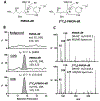Quantitation of Apurinic/Apyrimidinic Sites in Isolated DNA and in Mammalian Tissue with a Reduced Level of Artifacts
- PMID: 31055913
- PMCID: PMC6718090
- DOI: 10.1021/acs.analchem.9b01351
Quantitation of Apurinic/Apyrimidinic Sites in Isolated DNA and in Mammalian Tissue with a Reduced Level of Artifacts
Abstract
The apurinic/apyrimidinic (AP) site is a common lesion of DNA damage. The levels of AP sites reported in the literature cover a wide range, which is primarily due to the artifactual generation or loss of AP sites during processing of the DNA. Herein, we have developed a method for quantitating AP sites with a largely reduced level of artifacts by derivatizing AP sites before DNA isolation. A rapid digestion of nuclear protein was performed to minimize enzymatic DNA repair, followed by direct derivatization of AP sites in the nuclear lysate with O-(pyridin-3-yl-methyl)hydroxylamine, yielding an oxime derivative that is stable through the subsequent DNA processing steps. Quantitation was done using highly selective and sensitive liquid chromatography-tandem mass spectrometry, with a limit of quantitation at 2.2 lesions per 108 nucleotides (nts, 0.9 fmol on column). The method was applied in vivo to measure AP sites in rats undergoing oxidative stress [liver, 3.31 ± 0.47/107 nts (dosed) vs 0.91 ± 0.06/107 nts (control); kidney, 1.60 ± 0.07/107 nts (dosed) vs 1.13 ± 0.12/107 nts (control)]. The basal AP level was significantly lower than literature values. The method was also used to measure AP sites induced by the chemotherapeutic nitrogen mustard in vitro.
Figures




References
Publication types
MeSH terms
Substances
Grants and funding
LinkOut - more resources
Full Text Sources
Other Literature Sources

